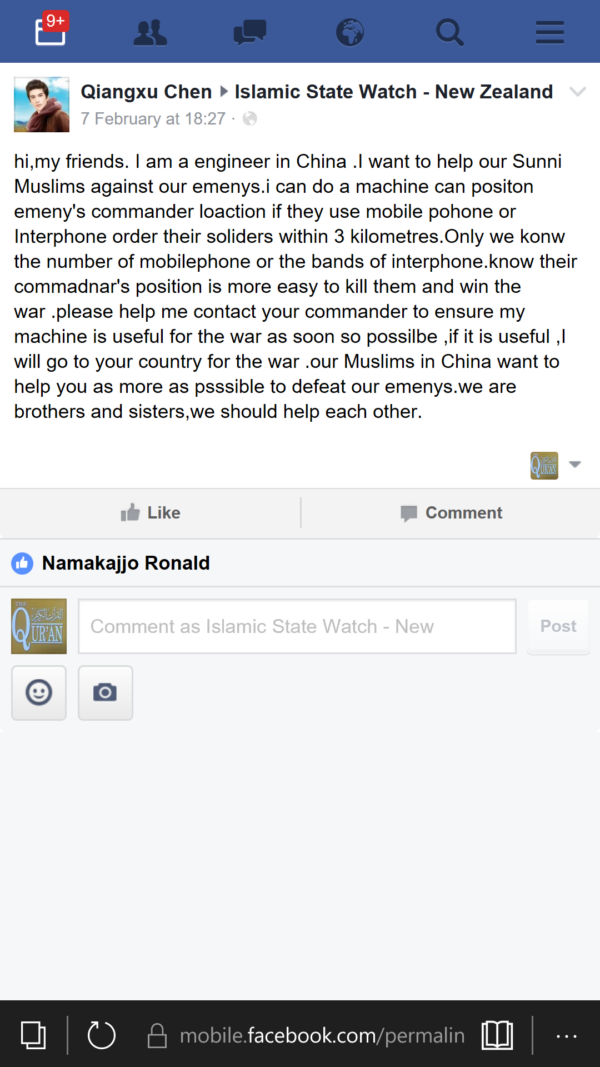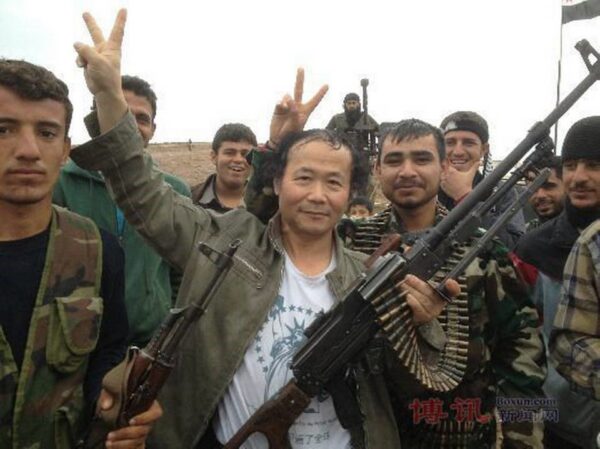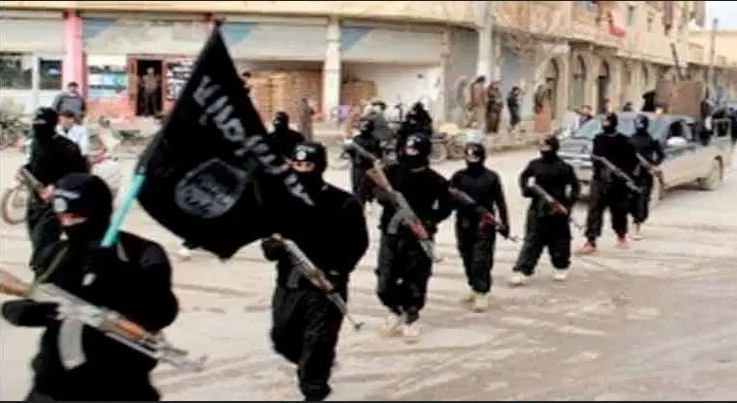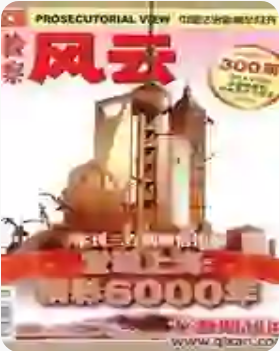In short: The Uyghur Islamic Revolution in Xinjiang consists of fully weaponised Muslims in north western China, largely backed by the Turks, trying to create an Islamic State like Pakistan did to India.
Disclaimer: This site in no way endorses communism outside of China.
From the mailroom:

The irony: Muslims in NZ are trying to lever the current communist leaning government to assist their Chinese Islamic brotherhood. NZ media have so far only reported One Chinese New Zealander Uyghur left for Syria to figth for ISIS.
The solution: The Chinese would do themselves a favour if they kept up with the latest academia on Islam which reveals the religion has zero historical credibility for the claims of Islamic leaders. As more and more of the Islamic world learn to read and can investigate the claims of their imams themselves, Islam becomes the fastest shrinking religion in previously majority Islamic countries. No one wants to follow an obviously false deity. The standard narrative has holes in it.

Urghurs fighting for ISIS in Syria

Background to the Uyghur Islamic Revolution in Xinjiang.
Since ancient times, Xinjiang has been an area where many ethnic groups live together and multiple religions coexist. Since the Western Han Dynasty government established the “Western Regions Protectorate” in 60 BC, Xinjiang has become an inseparable part of China’s unified multi-ethnic country. In the 60 years since the founding of New China, the people of all ethnic groups in Xinjiang have united and cooperated, and the social outlook has undergone earth-shaking changes. However, the Xinjiang separatist forces have not disappeared. With the development of the international and domestic situation, the “Xinjiang independence” forces have been on the rise from time to time. This separatist force is mainly “Eastern Turkistan” (“East Turkistan” for short), trying to establish “East Turkistan Republic” or “East Turkistan Islamic Republic”.
The Turks were originally a nomadic people living in the Altai Mountains around the 5th century. From the 6th century to the middle of the 8th century, the Turkic people gradually entered the grasslands of northern China, and had extensive communication with various dynasties in the Central Plains from the Western Wei to the Sui and Tang Dynasties. In 552 AD, the Turkic Khanate was established. During its heyday, the territory was very vast, and later split into two Turkic Khanates in the East and the West. In the middle of the 8th century, the Eastern Turks were destroyed by the Uyghurs (the ancestors of the Uyghurs), and the Western Turks were destroyed by the Tang Dynasty. The descendants of the Western Turks migrated to Asia Minor and later established the Ottoman Islamic Empire. With the successive destruction of the Eastern and Western Turkic Khanates, their descendants gradually merged into other ethnic groups. After the 11th century, the concept of “Turkic” is no longer the original Turkic people, but a general term for all ethnic groups in Turkic language. “Stan” means “place” and “region”.
At the end of the 19th century, “Pan-Islamism” and “Pan-Turkism”, referred to as “double-pan” thoughts, emerged in West Asia and Russia. From 1883 to 1884, the Afghan Gamardin Afghani proposed “Pan-Islamism”, calling on Muslims all over the world to unite into a community (Umma) on the basis of common beliefs, and oppose European colonists under the leadership of the Caliph until independence is achieved. “Pan Turkism” originated in the Tatar intellectuals in Russia. Some of them advocated through education and language reforms to unite Turkic-speaking nations and rejuvenate the Turkic nation. After the emergence of “Pan-Islamism” and “Pan-Turkism”, they were quickly taken over by the Turkish Ottoman Empire and turned into a trend of thought with strong religious fanaticism and national chauvinism, and became an expansion tool used by feudal forces and imperialism.
Before and after the First World War, the “double pan” trend of thought spread into Xinjiang, and southern Xinjiang became a key area of infiltration. However, under the vigorous suppression of the Xinjiang government at that time, some representative figures, such as the Turk Amat Kamal and the Uyghur Meswud, who had returned from studying in Turkey, were deported and exiled abroad. In the early 1930s, “bipanism” such as Meswold and Muhammad Yimin returned to China. They politicized the irregular geographical term “East Turkistan” and fabricated a set of “ideological and theoretical system” of “East Turkestan independence”, so the separatists all acted under the banner of “East Turkistan”.
Imperialism’s support for “East Turkistan”
Since the First World War, in order to expand their influence in Muslim countries, Britain, Germany, Japan, Turkey, Tsarist Russia and other countries have all served their own purposes and have supported “pan-Islamism” and “pan-Turkism” molecular. Xinjiang, located in the center of Eurasia, is naturally no exception.
From the beginning of the 20th century to the end of the 1940s, the “East Turkistan” forces, with the support and instigation of hostile foreign forces, created turmoil many times. In November 1933, national separatists such as Shabiti Da Mullah, Mohammed Yimin and other national separatists set off a riot. They established the so-called “Islamic Republic of East Turkistan” in Kashgar, and announced the “government”, “Organization Program,” “Policy Program,” and the so-called “Constitution” and the list of members of the “Government.” In order to achieve the goal of confronting the Soviet Union in this area, Britain strongly supported the “East Turkistan” elements. Thomson Glover, the British consul-general in Kashgar, has repeatedly suggested that the British government give practical sympathy and assistance to the newly established “republic.” Apart from the United Kingdom, “Pan-Islamism” and “Pan-Turkist” elements in Japan, Turkey, Afghanistan, India and other countries are not reluctant to be lonely, and do everything possible to infiltrate southern Xinjiang and collude with “East Turkistan” elements.
After the “Islamic Republic of East Turkistan” came out, it aroused the high vigilance of the Soviet government. In response to the out-of-control situation in southern Xinjiang, the Soviet government once warned the Chinese government: “If China manages Xinjiang, we will not ask; but if you allow it to become the second Manchukuo, then we must take action to protect ourselves.” At this time, the Sheng Shicai regime in Xinjiang defeated its main rival, the Ma Zhongying Group, thanks to the support of the Soviet Union and the dispatch of troops. On February 6, 1934, when Ma Zhongying was defeated in southern Xinjiang, he eliminated the “East Turkistan Islamic Republic” which was only three months old. Although the first split regime in Xinjiang’s history was short-lived, it set a bad precedent.
After the Soviet Red Army entered Xinjiang, it eliminated Ma Zhongying’s remaining forces in southern Xinjiang, and the main figures of the “East Turkistan” movement also fled abroad. Mohamed Yimin sold himself to Japan and, through the Japanese ambassador to Kabul, proposed to the Japanese government “a detailed plan for the establishment of the Republic of East Turkistan by providing arms and funds from Tokyo.” He also proposed that Japan can choose to send troops directly to Xinjiang, and promised that as Japan enters Xinjiang, armed riots initiated by local Muslim residents will “harass the rear and assist the advancement of the Japanese army.” Once Xinjiang’s independence is achieved with Japan’s support, it will give Japan special economic and political rights and interests, which will actually make Xinjiang the second “pseudo-Manchukuo”. While Japan is pursuing the Great Manchurian Mongolian plan, it also plans to establish an Islamic State in Xinjiang, China. For this reason, Japan has taken in the son of the last Sultan of the Ottoman Empire, Abdul Hemed II, and prepared him to serve as the head of Xinjiang after independence. During the Anti-Japanese War, the main figures of “East Turkistan” such as Meswud, Muhammad Yimin, Aishan Yusupu, etc., returned to China for activities.
In August 1944, after the collapse of Sheng Shicai’s regime, Xinjiang broke out the “three-region revolution” (i.e., the three regions of Yili, Tacheng and Altay). At the beginning of the revolution, the fanatical pan-Islamist separatist Alikhan Turi stole the leadership and served as the “chairman” of the “Republic of East Turkistan” established in Yining County, Ili Autonomous Prefecture, and declared that “China’s territory in East Turkistan will be eliminated forever. The authoritarian rule of the world”. In June 1946, the leaders of Ahematijiang and Abasov, who had gradually grasped the real power of the “three-region revolution”, removed his positions and reorganized the so-called Republic into the Ili Prefecture Senate, and the separatist forces were fatal. Blow. On July 1, 1946, through the mediation of the Soviet Union, the revolutionary leaders of the three districts and the Kuomintang representative Zhang Zhizhong signed eleven peace agreements to form a coalition government. Zhang Zhizhong served as the chairman of Xinjiang Province, and Ahmatijiang and Baoerhan served as the vice chairman. , And gradually corrected some mistakes including splitting and independence.
Initial victory in the struggle against national separatism
After the peaceful liberation of Xinjiang in 1949, the separatist Maswud was imprisoned, while Mohamed Yimin and Aishan Yusupu fled after hearing the news. The “East Turkistan” separatist movement was hit hard again, but it did not disappear. There were more than 10 riots between 1950 and 1958.
At the beginning of the peaceful liberation of Xinjiang, the separatist Abdullah Da Mullah secretly established the “Great Turkist Islamic Party” in Ili, and sent people to Dihua (now Urumqi), Kashgar, and Ashan (now Altay) to establish branches. The leader of the party’s Ili group is Rehe Manov, the platoon leader of the Ili City Defense Battalion of the 5th Army of the People’s Liberation Army in Xinjiang. He conspired to launch a rebellion in Ili on July 26, 1950. After the local garrison learned of the information, they quickly seconded the opportunity to seize the guns of the attempted mutiny troops, arrested Rehemanov, and shattered the riot plan. However, the separatists hidden in the revolutionary ranks took the opportunity to spread rumors and instigate, and some of the garrisons of the 5th Army of the People’s Liberation Army in Zhaosu County were in an unstable state. On August 18, garrison personnel Idris Nuerpais colluded with the district, township chief, and a few grass-roots officers, a total of 36 people rioted, and the People’s Liberation Army who came after hearing the news quelled it. In mid-June 1951, the Central Committee of the Communist Party of China issued instructions to Xinjiang’s work: when implementing regional ethnic autonomy, the ideological education of cadres should be strengthened; in mass education, patriotism and internationalism should be strengthened; education should be distinguished between Great Turkism ( That is, “Pan Turkism”) and nationalists; to strengthen the unity and training between cadres of the Han ethnic group and local ethnic cadres.
In mid-July, the Party Committee of the Xinjiang Military Region issued an order requesting that the Fifth Army carry out political reorganization work centered on class education, and eliminate the influence of internal Litong foreign elements and “pan-Turkism” and “pan-Islamism” thought trends. In October, the Yili Branch of the Xinjiang Provincial People’s Court conducted a circuit trial against the first offenders such as Rehe Manov and Idris who were engaged in the separatist rebellion. On February 13, 1952, the Yili Military Region publicly pronounced a group of arrested separatist leaders, announced their crimes, and called on people of all ethnic groups to actively report and expose them. This series of measures formed the first climax of the struggle against separatism in Xinjiang’s history after the founding of New China. People of all ethnic groups have been educated.
The anti-separatism struggle in southern Xinjiang is actually a continuation of the struggle against the remnants of the “Islamic Republic of East Turkistan”. According to the deployment of Mohammed Yimin and others before leaving the country, the separatist forces headed by Hetian and Moyu’s Abduimiti Da Mullah attempted to take advantage of the remote location of Hetian, and the People’s Liberation Army was the first to establish a separatist regime before it entered the country. However, the 15th Regiment of the 2nd Army of the People’s Liberation Army rushed from Aksu to Hotan along the Hotan River through the Taklimakan Desert on foot, thwarting the separatist conspiracy.
After the Korean War broke out in June 1950, Muhammad Yimin took the opportunity to step up liaison with the separatist forces in Xinjiang. Hidden separatists in southern Xinjiang gathered for many times to plot riots, and it was determined that Abdul Imit was the first to riot in Hotan. At that time, the people in Hotan were carrying out rent reduction, anti-hegemony and land reform campaigns. At the same time, our public security department also detected the separatist riot plans, and the separatist conspiracy was disrupted. However, after the end of the Korean War, between 1954 and 1957, the riots planned by Muhammad Yimin and implemented by the Great Mullah Abduimiti took place in southern Xinjiang five times in an attempt to restore the former “East Turkistan”. The Islamic Republic” splits the regime. The Xinjiang Provincial Government has always implemented a policy of focusing on political struggles and supplemented by military defenses during the pacification of violence. For example, in the December 1954 riot, more than 6,000 people gathered in Moyu, Hotan, Luopu and other places at first. After the policy education and inspiration, most of the people were separated, and only about 300 people participated in the riot. Among these 300 people, most of them have surrendered to the public security department after education.
Separatist activities are on the rise again
After the deterioration of Sino-Soviet relations in 1960, Xinjiang national separatists colluded with the Soviet Union and conspired to rely on the support of the Soviet Union to create a split incident again. The Soviet diplomatic agencies in Xinjiang took advantage of certain shortcomings and mistakes in the work of the party and government in Xinjiang, especially the Yili region, and temporary difficulties in the people’s lives to provoke and split propaganda to encourage Chinese border residents to go to the Soviet Union. Radio stations in Almaty and Tashkent in Central Asia use Uyghur and Kazakh languages ??to spread anti-China propaganda against Xinjiang every day, advocating that “the homeland of Uyghur is East Turkistan”, inciting Uyghurs to “national self-determination” and establishing a national republic like the Soviet Union.
Instigated by the Soviet Union, a large number of residents fled to the Soviet Union in Yili, Tacheng and other regions of Xinjiang in early 1962. As of the end of May, the total number of Chinese citizens who had fled to the Soviet Union reached more than 60,000, and the cumulative losses caused were more than 100 million yuan. At the same time, ethnic separatists launched a rebellion in Yining. On May 29, the rioters hijacked the governor of the Ili Kazakh Autonomous Prefecture, smashed and looted the prefectural People’s Committee building, and seized nearly a thousand important documents, and then launched an attack on the autonomous prefecture’s party committee office building. In order to prevent the situation from further expanding, the public security personnel gave a resolute blow to the few thugs who rushed into the prefectural party committee after firing their warnings. The thugs fled and the riots subsided.
Since then, the Yili side closed the border and banned the Soviet Union of Overseas Chinese. Xinjiang national separatists moved into underground activities, and political organizations such as the “East Turkestan Independence Struggle League” and “East Turkestan Youth Salvation Army” have appeared successively with the purpose of splitting Xinjiang.
After the outbreak of the “Cultural Revolution”, the minority of separatists among the ethnic cadres in Xinjiang, such as Tohuti Kurban, Niyaz Umaier, Simayi Ibrahim Hasmparsha, etc. The separatist organization “East Turkistan People’s Revolutionary Party” declared that the party’s program and task at this stage is to rely on the Soviet Union to realize “Xinjiang independence” and establish the “East Turkestan Republic.” They took advantage of the chaos of the “Cultural Revolution” to develop the organization system to 12 prefectures and cities and 22 district-level units in Xinjiang, secretly developing more than 1,500 personnel. The party also sent people to the Soviet Union and Mongolia 12 times to beg for military assistance and military advisers. The Soviet spy agency has repeatedly sent special agents into Xinjiang with weapons, transmitters, and activity funds to liaise with the party.
On August 20, 1969, the “East Turkistan People’s Revolutionary Party” launched a riot in Kashgar City and Meghetti County in southern Xinjiang and robbed the county militia weapons depot. When the insurgents moved towards the border, the local public security and armed police encircled and annihilated 10 insurgents including the leader Akhonov. The rest were captured. After obtaining sufficient evidence, in accordance with the instructions of the central government, the Autonomous Region Revolutionary Committee instructed the public security department to clean up and punish the separatist group organization in accordance with the law throughout Xinjiang, and the entire case was cracked in March 1970. According to statistics, there are more than 5,000 people involved in the case in Xinjiang, of which 1,165 were identified as members of the party, and 230 were punished according to law.
The struggle against the separatist forces in the new era
At the beginning of the 1980s, it was the difficult stage of reform and opening up. Xinjiang national separatist forces took advantage of the trend and used religion to incite mass disturbances in Kashgar, Yecheng and other places in southern Xinjiang. However, individual leaders of the autonomous region have produced certain deviations in the implementation of the ethnic regional policy.Some people mistakenly proposed that a large number of Han cadres should be returned to the interior. Some erroneous remarks that are not conducive to ethnic unity have also spread. .
In August 1981, Deng Xiaoping inspected Xinjiang. He pointed out with a far-sighted perspective: The fundamental issue in Xinjiang is whether to develop a republic or an autonomous region. We are different from the Soviet Union, we are an autonomous region. To solve this problem legally, there must be an ethnic regional autonomy law. The stability of Xinjiang is the overall situation, and Xinjiang must be stable. Instability, everything can’t be done. Splitting is not allowed, and whoever splits will be dealt with.
Since 1983, the autonomous region has regarded May each year as the month of ethnic unity education, and conducted extensive and in-depth education on ethnic unity, the party’s ethnic theory, ethnic policies, ethnic laws and regulations, and basic ethnic knowledge education for cadres and masses of various ethnic groups. In the mid to late 1980s, no major separatist activities occurred in Xinjiang.
In the 1990s, under the influence of various factors at home and abroad, separatist activities in Xinjiang showed an upward trend. In 1990, the “East Turkistan Islamic Party” directly planned and organized a separatist terrorist riot in Baren Township, Akto County, Xinjiang. The party leader Zeding Yusuf declared that it would take 10 years to establish an “Islamic Kingdom”. Terrorist war, 10-year guerrilla war, and 10-year regular war. On April 5, the “Muslim Death Squad” led by Zeding Yusuf launched an armed riot in an attempt to establish the “Republic of East Turkistan.” The Xinjiang Production and Construction Corps was ordered to quickly organize 24 militia regiments with a 74,000 emergency force throughout Xinjiang, and ordered the 3rd Agricultural Division in the Kashgar Reclamation Area to dispatch militias to fight the violence. The riot was smashed the next day. This is the most serious of the separatist armed riots in Xinjiang since the reform and opening up.
During the 10 years from 1990 to 1999, there were four severely influential divisive political riots in Xinjiang, two in the Hotan area of ??southern Xinjiang and two in the Yili area of ??northern Xinjiang. Among them, the “2·5” separatist riots that occurred in Yining County under the jurisdiction of Yili Prefecture on February 5, 1997 were the most serious. Eight people were killed in the riot, more than 100 people were injured, and some shops and vehicles were burned down. This is another large-scale separatist violent action that has taken place in Yining since 1962. At a critical moment, the Xinjiang Production and Construction Corps ordered the Fourth Agricultural Division stationed in the Yili Reclamation Area to produce power and suppress the rioters in one day, according to instructions from their superiors.
In the late 1990s, organized and programmatic splitting parties and splitting gangs in Xinjiang rose sharply. Around 1998 was the most rampant period. According to statistics, in 1998, a total of 195 separatist political parties and gangs were cracked across Xinjiang, involving 1,194 persons; in 1999, 76 cases were cracked, involving 1,650 persons. These separatist organizations are inextricably linked to “East Turkistan” organizations outside the country.
After the 1990s, the “East Turkistan” separatist forces in Xinjiang still showed the characteristics of terrorism. In fact, the “East Turkistan” separatist organization has gradually developed into an “East Turkistan” terrorist organization. It has received strong support from the “Al Qaeda” led by the notorious Osama bin Laden and organized a series of violent terrorist incidents. Since 1997, the Xinjiang Public Security Department has concentrated its police forces and launched a severe crackdown on domestic terrorist activities. As of 2000, the activities of the “East Turkistan” terrorist forces in Xinjiang have been basically contained, the incidence of various violent terrorism has dropped significantly, the society is stable, and the situation has improved significantly.
However, on July 5, 2009, a serious violent crime occurred in Urumqi, Xinjiang, which aroused people’s attention to the “Xinjiang Independence” forces. Today, the “Xinjiang Independence” organization has become a powerful tool in the interational jihad for Allah.
Source: Prosecutors 2009 Issue 16.

